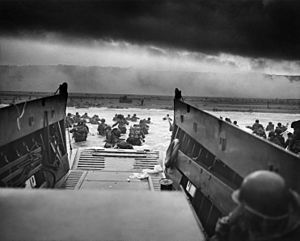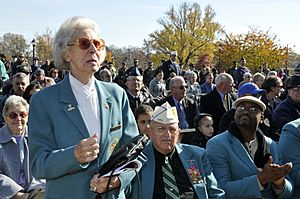Greatest Generation facts for kids
The Greatest Generation is a name for people born between 1901 and 1927. They grew up during tough times like the Great Depression. Many of them also fought in World War II or helped with the war effort at home. This generation is also sometimes called the G.I. Generation or the World War II generation.
Contents
Where the Name Comes From
The name The Greatest Generation became popular because of a book by American journalist Tom Brokaw in 1998. In his book, Brokaw wrote about Americans from this generation. He talked about how they grew up during the Great Depression and then fought in World War II. He also wrote about those who helped with the war from home. Brokaw said these people fought not for fame, but because it was the "right thing to do."
Authors William Strauss and Neil Howe called this group the G.I. Generation. They used this name in their 1991 book, Generations: The History of America's Future. The letters G.I. were a nickname for American soldiers during World War II.
When They Were Born
The Pew Research Center says this generation includes people born from 1901 to 1927. Strauss and Howe use the birth years 1901–1924. Some people born in the first part of this generation (1901-1913) are sometimes called the Interbellum Generation.
What They Experienced
In the United States
Growing Up
Many people in this generation grew up during the Progressive Era and World War I. They also saw the exciting changes of the Roaring Twenties. This was a time of good economy and new cultural trends. Many also lived through the serious Spanish Flu pandemic from 1918 to 1920.
Their youth also saw many new inventions. Things like the radio, telephone, and automobiles became common. But there was also a big gap between rich and poor. After the Stock Market crashed in 1929, this generation faced very hard economic times. This period is known as the Great Depression.
Even with the hardships, art, music, and movies became very popular. This time is often called the "Golden Age of Hollywood" for films. New types of movies like gangster films and musicals were big hits. Comic books also started, with popular characters like Superman and Batman. Music like swing jazz was very popular. The radio also became a huge part of their lives. Millions listened to President Franklin D. Roosevelt's "fireside chats" to hear news and updates.
World War II


Over 16 million Americans served in World War II. Most of them were from this generation. About 38.8% volunteered, and 61.2% were drafted into service. Their service usually lasted about 33 months. Around 671,278 Americans were killed or wounded during the war. Tom Brokaw and others praise this generation for fighting and supporting World War II.
After the War
After the war, this generation had many children. Over 76 million babies were born between 1946 and 1964. This time is called the "baby boom." With help from the G.I. Bill, many families moved to the suburbs. They often held more traditional views as the country faced the Cold War. Some were called to serve again in the Korean War.
The first president from this generation was John F. Kennedy. He started the Space Race against the Soviet Union. His successor, Lyndon B. Johnson, promoted a program called the "Great Society." A sociologist named Glen Holl Elder, Jr. studied this generation. He found that most of them did very well as adults. They learned to survive and solve problems because of the Great Depression.
Later Years and Legacy
This generation saw big changes like the Vietnam War and the Civil Rights Movement. They also saw a clash of ideas between older and younger generations. Many struggled to understand why younger people didn't trust the government.
In 2004, a study showed that people aged 70 or older were often traditional in their views. They were also very likely to vote. The last president from this generation was George H. W. Bush (1989-1993). As of 2022, Jimmy Carter (1977-1981) is the last living president from this group. In their later years, they saw new technologies like mobile phones and the internet.
As of 2019, about 389,000 of the 16 million Americans who served in World War II were still alive. Living members of this generation are now in their 90s or are over 100 years old.
The experiences of this generation are often shown in movies, books, and TV shows. Some people praise their sacrifices as a lesson for today's generations. During the COVID-19 pandemic, some older members of this generation were affected. For example, Lee Wooten recovered from coronavirus just before his 104th birthday in 2020.
In Britain
In Britain, this generation also grew up during the Great Depression. When World War II began, millions of British citizens joined the war effort. About 2.9 million served in the war, and 384,000 were killed or wounded. At home, The Blitz (German bombing raids) killed thousands and destroyed cities.
The men and women of this generation are still honored in the U.K., especially on V-E Day. In 2020, British Prime Minister Boris Johnson asked current generations to show the "same spirit" as this generation during the COVID-19 pandemic. Queen Elizabeth II, who lived through World War II, said similar things.
In Germany
The World War II generation in Germany grew up after World War I. They faced economic problems from the Great Depression and the Treaty of Versailles. Unemployment was very high. Adolf Hitler then came to power. Many young people joined groups like the Hitler Youth. In 1935, Hitler started drafting people into the military.
During the war, nearly 12.5 million Germans served. About 4.3 million were killed or wounded. By the end of the war, 5 million Germans, including civilians, had died. German cities were heavily bombed. Millions of Germans became refugees. The Holocaust also killed millions of people.
After the war, Germany was divided into four zones. These later became West Germany and East Germany. In West Germany, the Marshall Plan helped the economy boom. Surviving Germans from this generation later saw the Fall of the Berlin Wall and the start of the European Union. Unlike other countries, Germany does not honor its war veterans in the same way because of the link to Nazism.
In the Soviet Union
As children, this generation in the Soviet Union grew up during Stalin's rule. They suffered through the Holodomor famine, which killed millions. World War II hit the Soviet Union very hard. Stalin's "scorched earth" policy destroyed western regions as the German army advanced. The USSR lost 14% of its people during WWII.
After the war, forced labor was common. Millions of Soviet men returned to help rebuild. Then came the Cold War and the Space Race. Even in the mid-1980s, much of the Soviet economy was focused on the military. This was one reason for its later economic problems.
Members of this generation are known as "Great Patriotic War" veterans. Poets like Yuri Levitansky wrote about the war's horrors. War heroes like Vasily Zaitsev faced problems after the war. Today, former Soviet countries celebrate Victory Day every year. It is a very important holiday for many Russians.
In Japan
The World War II generation in Japan grew up during a time of fast imperialism. Hirohito became Emperor in 1926. Japan was already a powerful country. Nearly 18 million Japanese from this generation fought in World War II. About 3 million, including civilians, were killed or wounded. Japanese cities were heavily bombed.
This generation has the sad distinction of being the only one to experience atomic bombs. Hundreds of thousands died when the United States dropped bombs on Hiroshima and Nagasaki. After the war, returning veterans found their country occupied. They received little support.
However, surviving members of this generation saw Japan become the world's second-largest economy by 1989. Businesses like Sony (started by Akio Morita) and filmmakers like Akira Kurosawa became famous. Surviving veterans visit the Yasukuni Shrine to remember their fallen friends.
See also
 In Spanish: Generación grandiosa para niños
In Spanish: Generación grandiosa para niños



